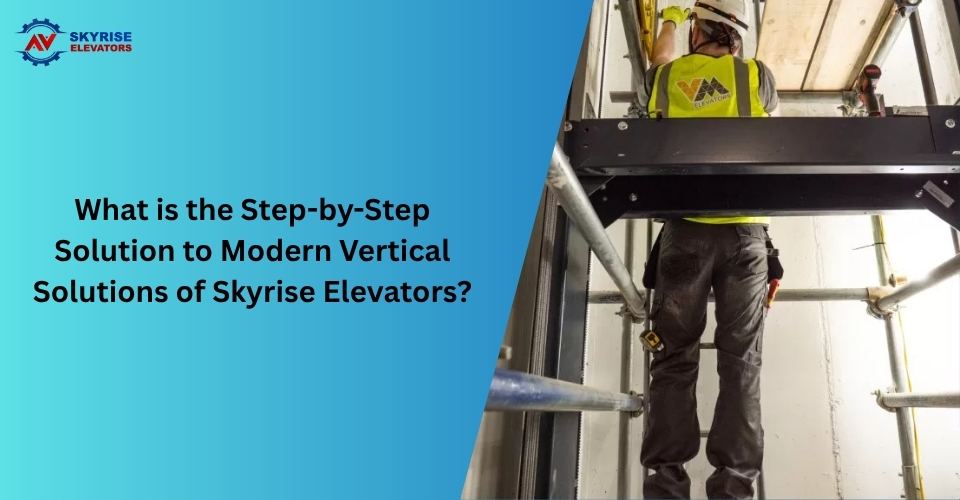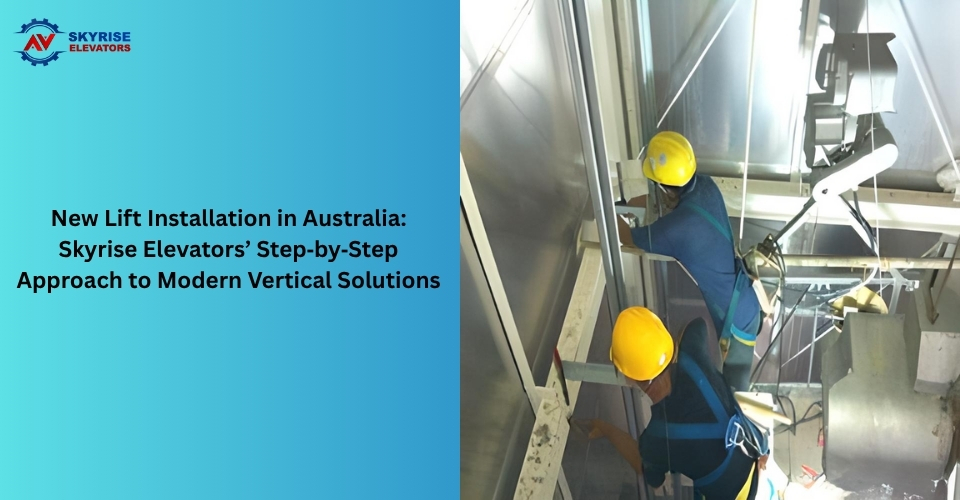New Lift Installation in Australia: Skyrise Elevators’ Step‑by‑Step Approach to Modern Vertical Solutions
It is not a matter of selecting the size of car and a finish that can possibly be bestowed in having a new lift installed in specification but rather designing a compliant, lifecycle cost effective, future ready system that is being able to serve its occupants efficiently satisfying Australian Standards and more importantly the cost to maintain such a project over its lifecycle is predictable and reliable.
Traffic analysis, turnkey commissioning right through to the provision of new elevator structures Skyrise Elevators delivers using a structured, de-risking delivery model which de-risks schedules, budgets, and building authorizations.
What is the Step-by-Step Solution to Modern Vertical Solutions of Skyrise Elevators?

The step starts with a feasibility study that is done to test the height of building, the flow traffic, and limiting technical factors like the size of shaft, the depth of pits, and availability of headroom. It is essential that the type of lift (gearless traction, hydraulic, or machine-room-less (MRL)) be selected.
Skyrise Elevators offer professional advice toward the most effective system considering energy consumption, maintenance cost, and accessibility including buttons with tactile graphics, announcements, acceptable door sizes, and so forth.
Sustainability and Smart Technology is also stressed in the modern new lift installation projects. Regenerative drives, destination control systems and energy saving stand by modes are features that improve performance and reduce operation costs.
Skyrise Elevators considers all these technologies in every project to define such a progressive solution. They also use BIM (Building Information Modeling) coordination of their work and guarantee smooth connections with other building systems in the construction process.
Safety / Quality Testing
Testing on safety and quality is a very important stage of installation. All systems are subject to speed accuracy checks, emergency communication checks and ride comfort checks. After all performance requirements of the lift have been fulfilled, Skyrise offers end-user training, substantial documentation about the lift, and digital monitoring capabilities to track the performance in real-time.
One more reason that makes Skyrise Elevators stand apart is its attachment to the open-protocol technology, which does not bind the building owners to paying huge sums to a specific vendor to maintain its elevators. With this flexibility, increment happens easier and incurrence of future costs is lowered.
Also, when designing their projects, they take future necessities into account, either in case they need the system to expand or change its appearance or in case it is in need of more capacity, so that the system can be used to the present day.
Phase 1: Feasibility & traffic analysis
Before drawings or tenders, you need evidence. Traffic simulations assess peak‑hour demand, interval times, handling capacity, and redundancy needs. This ensures the system can handle move‑ins, peak office flows, or hospital surge conditions without bottlenecks. Early feasibility also evaluates shaft dimensions, pit/headroom constraints, machine room availability (or MRL suitability), and structural loading.
Phase 2: Code, standards & stakeholder alignment
Australian Standards (AS 1735 series), NCC requirements, disability access provisions (AS 1428), and fire service operation rules shape system design. Early engagement with certifiers, fire engineers, and accessibility consultants avoids late rework. Clear alignment on these inputs guarantees your new lift installation will pass inspections without costly redesigns.
Phase 3: System selection, MRL, traction, or hydraulic?
Choosing the right technology depends on building type, height, traffic profile, and budget:
- Gearless traction (MRL or with machine room): Energy‑efficient, smooth, and ideal for medium‑ to high‑rise applications.
- Hydraulic lifts: Cost‑effective for low‑rise, heavy‑duty use (e.g., goods lifts), but with higher energy consumption without modern upgrades.
- Destination control systems: Reduce waiting and travel times by batching passengers intelligently, perfect for premium offices or mixed‑use towers.
Working with Skyrise Elevators means getting impartial guidance on OEM options, open‑protocol controllers, and future‑proof modernisation paths.
Phase 4: Design development & BIM coordination
Tight coordination with architects, structural engineers, and services consultants is non‑negotiable. BIM modelling resolves clashes (HVAC ducts through the shaft, anyone?), while coordinated shop drawings lock down door widths, sill details, power requirements, and fire detection interfaces. Accessibility features, tactile buttons, audible cues, compliant control panel heights, are baked in from day one.
Phase 5: Procurement strategy, open protocol, transparent warranties
Avoid vendor lock‑in by specifying open‑protocol controllers and widely available components. Competitive procurement should include:
- Clear performance specs (speed, capacity, interval targets)
- Robust warranty terms and defined response times
- Obsolescence policies and spare‑parts continuity
- Energy‑efficiency benchmarks and standby modes
Phase 6: Construction, installation & site safety
A safe, clean worksite protects schedules as much as people. Key practices:
- Lift shaft protection and exclusion zones to keep other trades safe
- Just‑in‑time delivery of rails, cars, and controllers to minimise storage damage
- QA checkpoints at each installation milestone (guide alignment, car frame assembly, wiring verification)
Phase 7: Testing, commissioning & certification
Commissioning verifies performance against the specification:
- Speed, acceleration, and deceleration profiling
- Door timing, safety edge responsiveness, and nudging parameters
- Emergency lowering, two‑way communication, and lighting tests
- Ride quality measurement (vibration, noise)
Independent inspections, final certifications, and comprehensive O&M documentation finalise handover, ensuring your new lift installation is legally compliant and operationally ready from day one.
Phase 8: Handover, training & digital monitoring
Handover isn’t the end, it’s the start of operations. Facility teams receive:
- Training on daily checks, emergency procedures, and BMS integrations
- Access to remote monitoring dashboards (fault logs, drive temperatures, traffic analytics)
- Preventive maintenance schedules aligned to warranty conditions
Energy efficiency & ESG outcomes
Modern drives, regenerative braking, LED lighting, and sleep modes deliver material savings over a lift’s 20‑25 year life. Smart analytics can further optimise call allocation, reduce idle energy, and support ESG reporting.
Accessibility & user experience
A truly modern system is inclusive: braille and tactile markings, voice annunciation, visual indicators, mirror placement, railing design, and intuitive car operating panels matter as much as capacity and speed. These elements ensure equal access while elevating perceived building quality.
When future modernisation is built in
Designing with modularity, controllers that accept future destination control upgrades, door operators that handle heavier panels, shafts sized for higher car capacities, protects your capex for decades. This foresight avoids demolition and structural works when the time comes to up‑spec.
For new lift installation projects that demand airtight compliance, predictable costs, and an impeccable user experience, Skyrise Elevators delivers a structured, evidence‑based approach from feasibility to final certification. Specify smarter, coordinate earlier, and commission with confidence, so your building moves people safely, efficiently, and sustainably for decades.










